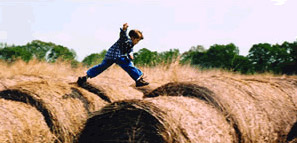The Future of Agriculture in Alabama: Reinventing E.V.Smith Research Center, Part I

While Alabama is still considered a "rural" state, agriculture in Alabama has changed, and with this change have come plans for the re-creation of the Alabama Agricultural Experiment Station's (AAES) E.V. Smith Research Center as the Center for Sustainable Rural Living (CSRL).
The 3,200-acre E.V. Smith Research Center at Shorter, Ala., is located on Interstate 85, making it the most visible Auburn agricultural facility in Alabama. Established in 1978 to provide the knowledge base required for a productive agriculture in Alabama, E.V. Smith Research Center currently provides facilities for research programs in animal science, agronomy and soils, horticulture, entomology, plant pathology and agricultural economics.
The CSRL will focus on sustainable agriculture technology and systems that promote rural living, rural culture and rural lifestyles. It will offer Alabamians new strategies to better utilize and protect their land, natural resources and rural heritage. The ultimate goal will be a stronger economy and a better job outlook for rural Alabama.
"It's important to educate people about the value of agriculture in Alabama," states John Jensen, who served as interim director of the AAES when the idea for reinventing E.V. Smith Research Center was first developed. "Reinventing E.V. Smith Research Center as the Center for Sustainable Rural Living will help us let the citizens of our state know what we do, and how important agriculture and we are to the state."
The effort began with the work of Natural Resource Conservation Service employee Bill Puckett. It has been continued by Joseph Molnar, CoAg professor of rural sociology, and Sandra Solaiman, professor of animal sciences at Tuskegee University, who are serving as co-chairs of a CSRL steering committee that was established in late June. Puckett spent five and a half months–from Nov. 6, 2003, until April 16, 2004–developing an "action plan" for transforming the E.V. Smith Research Center from a traditional agricultural experiment station into a new and innovative agricultural research, education and demonstration center for Alabama.
"My role was to develop a new vision for the E.V. Smith Research Center," says Puckett. "It was my responsibility to bring together diverse groups of stakeholders and forge from them a common vision for what they could support at E.V. Smith."
To that end, Puckett met with representatives from the Alabama Cooperative Extension System, AAES and the Auburn University School of Forestry and Wildlife Sciences and colleges of Agriculture; Architecture, Design and Construction; Human Sciences; Veterinary Medicine; and Sciences and Mathematics.
He also met with representatives of other entities ranging from the Auburn University Environmental Institute and Alabama A&M and Tuskegee Universities to the Alabama Department of Agriculture and Industries, Alabama Farmers Federation, Alabama Sierra Club, Alabama Sustainable Agriculture Network, Heifer International, I-85 Corridor Initiative groups, Mt. Laurel Organics, Southern Sustainable Agriculture Working Group and the USDA's Sustainable Agriculture Research and Education and Agricultural Research Service.
Already two grant proposals related to E.V. Smith's reinvention have been submitted and three additional grant proposals are being developed for submission later this year to USDA and the Kellogg Foundation.
The steering committee, under the leadership of Molnar and Solaiman, has continued Puckett's work, establishing subcommittees on research, a visitor's center and agricultural and environmental education.
"Our steering committee and subcommittees are taking inventory, touring and fact-finding right now. We will have a final report ready late this year," states co-chair Molnar. "Questions, concerns and suggestions can be sent to members of the steering committee."
Steering committee members include Molnar and Solaiman; Jim Bannon (AAES director of outlying units); Charlene LeBleu (College of Architecture); Robert Zabawa (Tuskegee); David Weaver, Keith Cummins and Joe Kemble (College of Ag); and Randy Rapier (USDA-ARS National Soil Dynamics Laboratory).
A final report is due out in late 2004 and will be the focus of "Reinventing E.V. Smith, Part II" that will appear in a future issue of Ag Illustrated.
